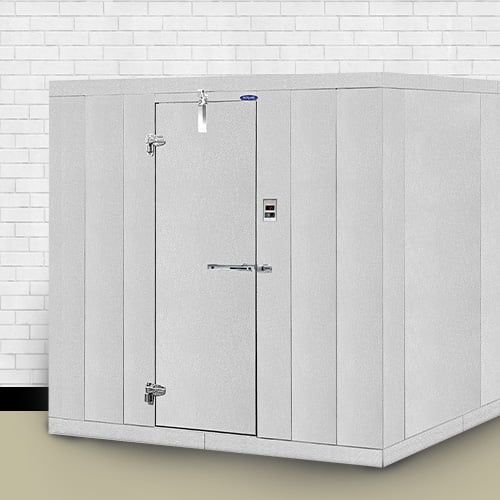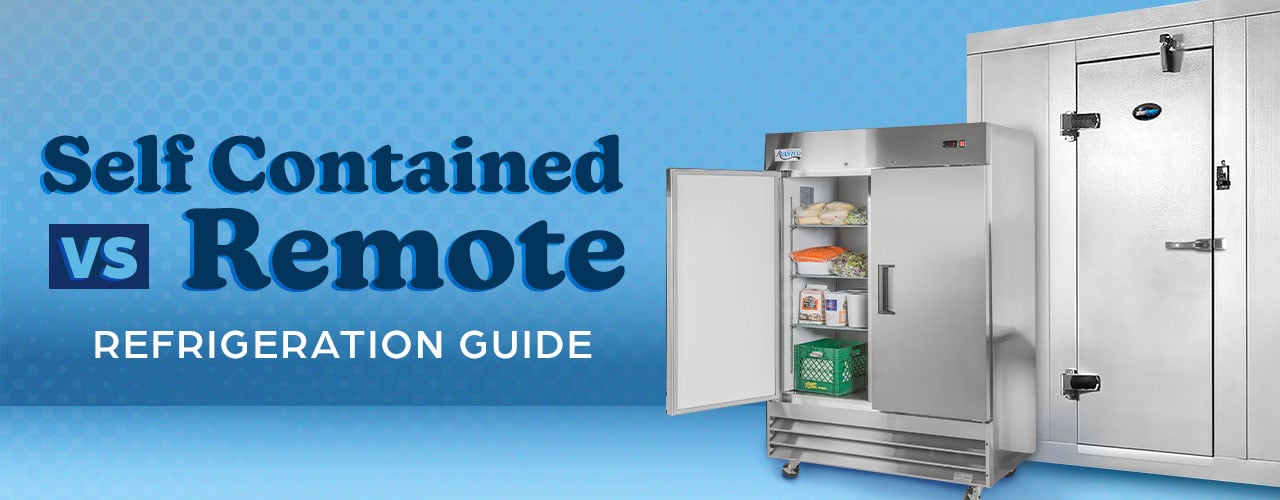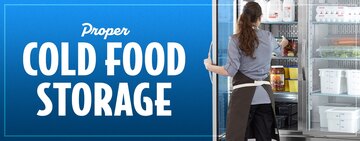Self Contained vs Remote Refrigeration
Last updated on Oct 2, 2024Janine JonesUnderstanding the differences between self-contained and remote refrigeration is crucial when it comes to choosing the right refrigeration system for your commercial kitchen. Self-contained units keep both the refrigeration system and the storage compartment in a single piece of equipment, making them ideal for smaller spaces or mobile applications. On the other hand, remote refrigeration systems (most common for walk-in coolers) separate the compressor and condenser unit from the storage area, allowing for quieter operation and greater flexibility in design. Let's explore the key factors to consider when deciding between self-contained and remote refrigeration to help you make an educated decision for your kitchen layout and budget.
Shop All Walk-In Refrigerators and CoolersWhat Are Self-Contained Refrigeration Units?
Self-contained refrigerators are appliances that house all of their components, such as the condenser and evaporator, inside the unit itself. These types of refrigerators, walk-in coolers, and prep tables are the most popular options used in foodservice, with nearly 90% of refrigerators used in commercial kitchens being self-contained.
Pros of Self-Contained Refrigeration
Self-contained units are commonly used in smaller commercial spaces due to their simplicity and ease of installation. Self-contained refrigeration systems are ideal for businesses with limited space or those needing a portable cooling solution. Here are some benefits of choosing a self-contained refrigeration unit:

- Ease of Purchase: Everything you need to set up your self-contained walk-in refrigerator comes in one convenient purchase.
- Easy Installation: Self-contained refrigeration units are designed for quick and easy installation, making them a convenient choice for businesses looking to set up refrigeration systems with minimal downtime.
- Space Efficiency: These units are compact and self-contained, saving valuable kitchen space that can be utilized for other equipment or storage needs.
- Energy Efficiency: Self-contained refrigeration systems have energy-efficient options, helping businesses reduce their overall energy consumption and operational costs.
- Lower Maintenance Costs: With fewer components and parts compared to remote systems, refrigerator maintenance for a self-contained unit generally comes at a lower cost as they are easier to service.
- Versatility: Self-contained units are versatile and can be placed in various locations within a commercial kitchen or foodservice establishment, providing flexibility in design and layout options.
Cons of Self-Contained Refrigeration
While self-contained refrigeration units are convenient for smaller commercial spaces, they may not be suitable for larger establishments or warmer climates. Here are a few downsides to choosing a self-contained unit for your restaurant:
What Are Remote Refrigeration Units?
Remote refrigeration units are refrigeration systems where the condensing unit is located separately from the evaporator unit. For example, the compressor and condenser of a remote walk-in cooler are typically placed outdoors or in a different area from the evaporator, such as on the roof (depending on the climate) or in a cool basement. This allows for quieter operation and better heat dissipation.
Pros of Remote Refrigeration
Remote refrigeration systems are ideal for commercial kitchens where noise level and heat output are a concern, as well as for spaces with limited ventilation or low ceilings. Remote refrigeration units are commonly used in larger foodservice operations such as supermarkets, large convenience stores, and commissary kitchens. Here are some key benefits of remote systems to consider:

- Reduced Heat Emissions: Remote refrigeration systems are located outside of the commercial kitchen or foodservice area, which means they do not release heat into the workspace. This can help maintain a comfortable working environment for staff and reduce the load on air conditioning systems.
- Quieter Operation: Since the compressor and condenser of a remote refrigeration system are located in a separate unit, these systems operate more quietly compared to self-contained units. This can create a more pleasant dining experience for customers and a quieter work environment for employees.
- Improved Energy Efficiency: Remote refrigeration systems can reduce the strain put on a compressor and condenser caused by a warm environment. If a kitchen is already warm, the unit will need to work harder to cool the items in the storage space. By placing the heat-producing components outside, remote systems can operate more energy efficiently.
- Alternative Installation Options: Remote refrigeration systems offer flexibility in terms of installation locations. They can be placed on rooftops, outside buildings, or in other areas that are away from the main kitchen space. This flexibility can be advantageous for businesses with limited indoor space or specific layout requirements.
- Scalability: Remote refrigeration systems can be easily expanded or modified to accommodate growing business needs. This scalability allows for future-proofing your refrigeration setup and making adjustments as your business expands or changes.
Cons of Remote Refrigeration
Remote refrigeration systems, while beneficial in many ways, also come with certain drawbacks that should be considered before making a decision for your commercial kitchen. Here are some key points to keep in mind:
Choosing between self-contained and remote refrigeration systems depends on various factors such as space availability, noise levels, and maintenance preferences. Whether you’re opening a new restaurant or expanding your existing space, you’ll need to consider your specific needs and budget constraints when deciding which refrigeration option is best suited for your commercial kitchen.



